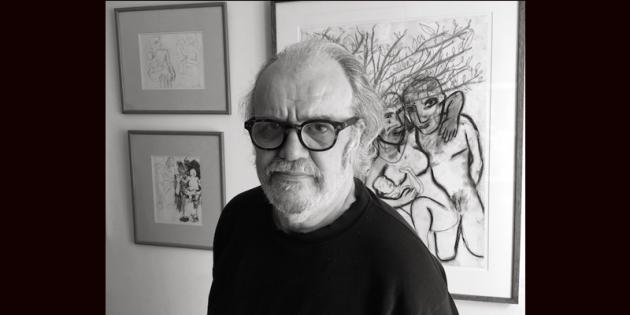The first retrospective exhibition of the Welsh (born 1955) photographer Chalkie Davies is about to launch at the National Museum of Cardiff 9 May – 6 September 2015. ‘Chalkie Davies – The NME Years’ explores his photographs of musicians taken from the 1970s and 1980s. The exhibition looks mainly at the much revered Rock and Punk era, celebrating 40 years since his career at the NME began. The event will also coincide with the artist’s 60th birthday.
This retrospective features a collection of 64 black and white images, many of them not seen before in public, in their original form. It includes many seminal bands and musicians including: The Clash, The Specials, Sex Pistols, Elvis Costello, David Bowie, Thin Lizzy and The Who.

Mr Davies grew up in Sully, South Wales, and was drawn to the center of the music industry, in London at the age of 16. While there he discovered a passion for photography. He began his career when he photographed David Bowie on his Ziggy Stardust tour and by 1975 Davies was employed as a staff photographer for NME. He shot all the key players in this ground-breaking and much revered musical era.

It was the heyday of the NME’s popularity with over 200,000 copies selling every week. Whilst bands and musicians were usually photographed live, or while being interviewed, Chalkie preferred to pose his subjects, often using carefully chosen backgrounds from around the globe. He followed his subjects, frequently visiting America, Europe and even Asia, working with artists like Ian Dury, Debbie Harry, Elton John, Keith Richards and Paul McCartney.

After leaving NME in 1979, Chalkie went on to contribute to a new music magazine called The Face. At the same time he was photographing record covers for The Specials, The Pretenders and Elvis Costello. He subsequently moved into the studio where he shot LP sleeves and formal portraits for artists like Pete Townshend, David Gilmour and David Bowie.
He says, “Music was the one thing that really interested me when I was a teenager in South Wales, that and electronics, I had this dream of working for a band, but I never had any aspirations of being in the group itself, I also borrowed my father’s camera and used to go off taking pictures at Barry Scrapyard, this was where all the steam trains were sent to die.
“I am very humbled that National Museum Cardiff is hosting my photography in this retrospective. This exhibition brings together my work from a special time in the world of music. It is a mixture of documentary work for the NME and a collection of unseen studio portraits of people like Suggs, Ian Dury, Joe Strummer, Chrissie Hynde and Paul Weller.
“Photographically, I have led a privileged life, albeit an elusive and reclusive one, but as the ripe old age of sixty approaches I think it might be time to tell my tale, how a kid from Sully can go to London all alone, end up getting the one job he always wanted and then to work with all the people he admired, to help shape and mould them visually, to create the images the fans would see and most importantly remember.

Chalkie left the NME in 1979 when the new editor brought in one of Chalkie’s friends, Anton Corbijn. Davies, at this point in his career, started to create record covers instead. In the mean time, he had met his wife, fellow photographer Carol Starr, in Toronto. His close friend Elvis Costello introduced Chalkie to The Specials, a new Two Tone band from Coventry, whose LP was in production. Starr and Chalkie began working together, and their first record sleeve was The Specials debut album, in 1979.
During the 1980s, while working on record covers and The Face, Chalkie also focused on studio portraiture. He photographed such famous faces as Chrissie Hynde (The Pretenders), Suggs (Madness) and Pete Townshend (The Who). The intensity of this studio portraiture allows the character of the sitter to come through, beyond that seen in a live performance shot. Chalkie and Starr both had cable releases to the Hasselblad camera. This allowed them a unique viewpoint as they could take pictures simultaneously or separately and therefore get two different points of view.

However, there came a point in the mid-1980s when Chalkie decided it was time to move on. He had produced fashion and still life photography, in addition to music photography, for Arena and The Face which gave him the idea for his next venture. Chalkie moved with his wife Carol Starr to New York where they set-up a photographic studio called Davies and Starr producing mainly high quality still life photographs for products.
Top Photo: P C Robinson © Artlyst 2015 Others © Chalkie Davies courtesy National Museum Cardiff All Rights Reserved


